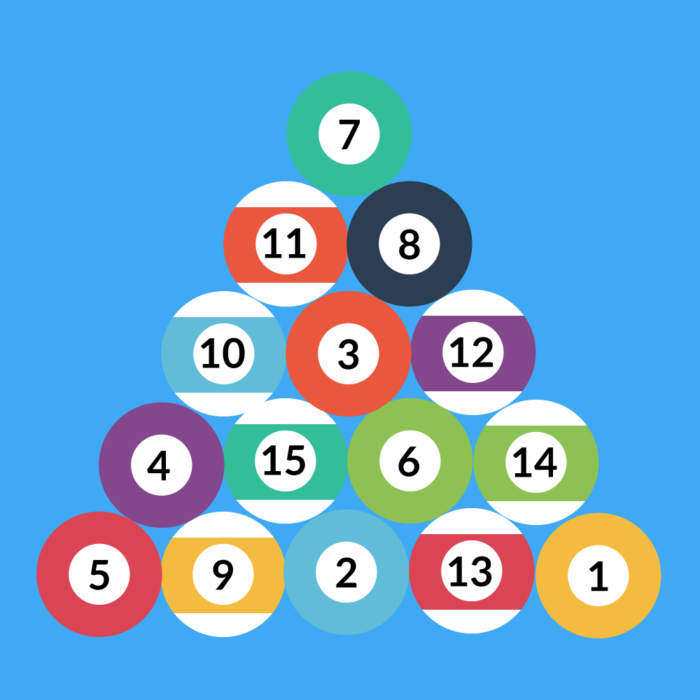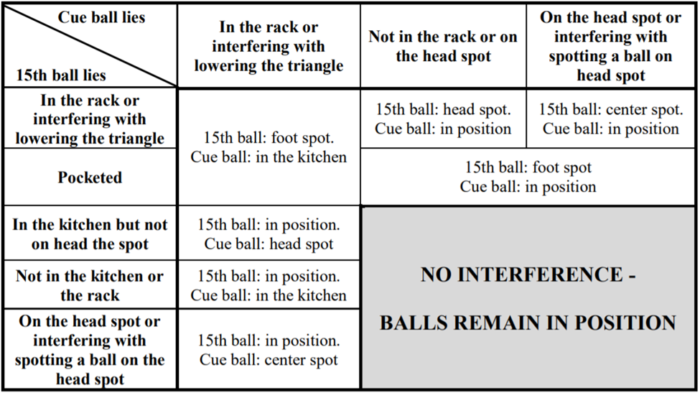Straight pool, also known as 14.1 Continuous, is a call shot game which uses 15 numbered balls and one cue ball. The objective of the game is to make the numbered balls into the pockets, where each made ball counts as 1 point. Before clearing all 15 balls in a rack, play is stopped after 14 balls on the table are made to re-rack the previously pocketed balls while leaving the remaining object ball and cue ball in place where they lie. After the balls are re-racked you can continue playing. The first to score 150 points wins the game.
Determining Who Breaks
To determine who breaks in Straight Pool, the two competing players must lag for the break. A lag is performed by placing two object balls on the table behind the head string (in the kitchen). Each player will select one of the object balls to shoot and will shoot at around the same time. To perform the lag both players must shoot their ball towards the opposite end rail of the table, and back towards the rail they stand over at the opposite end of the table. Whichever ball stops closest to the end rail wins the lag.
The winner of the lag determines who breaks to start the game.
Straight Pool Rack
All 15 numbered balls are used in the rack to start the game. A triangle rack should be used to rack the balls on the foot spot of the table. The ball at the apex of the triangle should be placed directly on top of the spot with the 1 and 5 balls at the corners of the rack. All other balls should be placed randomly in the rack.

Rules for Breaking
Once a breaker has been decided after the lag, the cue ball can be placed anywhere behind the head string. To break the breaking player must shoot the cue ball into the rack with their cue stick. After the cue ball makes contact with the rack, the cue ball and at least two object balls must hit a rail.
If these objectives are not met, then the shot was not a legal break and is a foul. 2 points are to be deducted from the breaking players score (the score can be negative), and the opposing player gets the choice to play the balls as they lie or request the balls be re-racked and broke again by the breaking player.
Legally Pocketing a Ball for a Point
In order to legally pocket a ball, the shooting player must call the ball they intend to pocket and which pocket they intend to pocket it in. This includes the break shot. If the player successfully makes the ball that they called a point is added to their score.
If the player makes a called ball in the correct pocket and another ball is pocketed that wasn’t called in the same shot, both balls are added to the shooting player’s score.
Not Called Balls
If the shooting player makes a ball into a pocket that was different than the pocket that was called, the player receives no points for making that ball and the pocketed ball is removed from the pocket and placed back onto the spot of the table. The shooting player also turns over control of the table to the opposing player. No penalty or foul is awarded to the shooting player.
Legal Shot
A legal shot is a shot where the cue ball hits an object ball and after contact with an object ball, either the cue ball or any other object ball hits a rail. If no rail is struck the shot is not legal and is a foul.
Spotting Balls
Balls that are incorrectly called and need to be respotted must be placed taken out of the pocket and placed on the foot spot of the table. If the foot spot is obstructed by balls that are in that area, the re-spotted ball should be placed as close to the foot spot behind the obstructing ball as possible, towards the end rail of the table.
Scratching in Straight Pool
When the shooting player causes the cue ball to be pocketed, or an object ball to jump off the table the shot is a scratch and a foul. Any scratch results in -2 points taken from the shooting player’s score.
On a cue ball scratch, the opposing player can place the cue ball anywhere behind the head string to shoot their shot. Scratched object balls should be re-spotted.
Successive Fouls
If a player commits a foul that -1 point is deducted from their score. If the same player commits a foul on their next shot, -1 point is deducted from their score. Should a 3rd foul be played on that players next shot, -1 point is deducted from their score as well as a further -15 points from their score.
All 15 balls must then be re-racked and the opposing player gets to decide who breaks.
Racking Subsequent Racks – Placement of Cue Ball and 15th Object Ball Based on Position
When racking for subsequent racks after the break, the positions of the cue ball and 15th ball determine where they should be placed. Cue Sports International has built a matrix to help determine where balls should be racked in specific situations.

